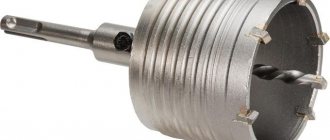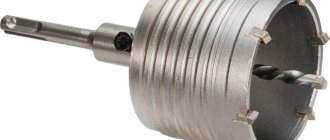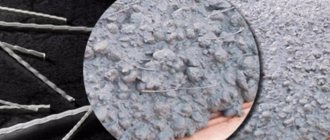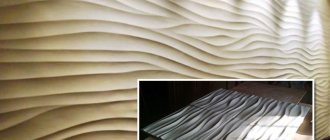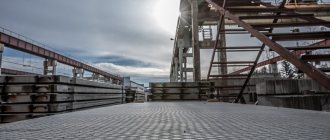Wet cement production technology
The production of cement using the wet method begins in the same way as in any other case: with the extraction of solid limestone from quarries, which is then crushed into pieces of different sizes. Then the pieces are crushed in special crushing units until the limestone fraction is equal to a maximum of 8-10 millimeters.
Then clay from the quarry is delivered to the plant, it is processed in roller crushers until the size of the pieces is a maximum of 100 millimeters. The crushed clay mixture is soaked in mash until a clay slurry with a moisture content of 70% is obtained. The sludge is then sent to a mill where it is mixed and ground together with limestone.
Next, the sludge, the humidity of which is already at the level of 40%, is sent to a vertical pool, where the final adjustment process is carried out. This operation is extremely important, since it is here that the correct chemical formula of the sludge composition is formed and ensured.
After checking the quality of the sludge, it is transported for the subsequent stages: the cement mass is transported from a vertical basin to a horizontal one, where the mixture is stored before being sent to the kiln. The raw materials in the horizontal pool are constantly mixed mechanically using compressed air. This prevents the sludge from settling and allows it to completely homogenize.
In cases where cement production involves the use of raw materials with an unchanged chemical composition, adjustment of the sludge composition is carried out in a horizontal pool.
The sludge is then sent to a kiln for firing, where it is turned into clinker. The resulting clinker base is sent to an industrial refrigerator and cooled there. Then the clinker is crushed, fed into mill containers, and ground again to a powder state.
In the case when the process of burning sludge requires the use of solid fuel, it is necessary to take care of the construction of an additional room (where coal will be stored and prepared). If the technological scheme for cement production requires the use of gaseous/liquid fuel, the clinker burning process is simplified.
At the final stage of production, cement from the mill bunkers is sent to special rooms where it is stored. Here laboratory technicians examine the quality of products and determine the brand. Only after the inspection is completed can the cement be sent to the packaging machines.
Advantages
When considering the wet method of cement production, it is worth considering its pros and cons. Like any technological process, this one has its own characteristics.
Key advantages of the wet method of cement production:
- Reduced technological costs for grinding the raw material base - clay and chalk are perfectly wetted in water in the pool during primary processing, and therefore are crushed more easily and simply.
- Transportation, homogenization, and adjustment of sludge are simpler and safer from an environmental point of view, especially in comparison with similar processes in the production of cement using the dry method.
- Much less dust is generated.
- Firing furnaces are simple in design, reliable, and have a high space utilization coefficient (varies between 0.89-0.91).
- It is possible to use components with a fairly “variegated” (different) chemical composition in production, and good sludge homogenization is also ensured.
Flaws
There are few disadvantages in the wet method of cement production, but they exist and cannot be ignored.
The main disadvantages of the wet method of cement production:
- High specific consumption of thermal energy during the firing of raw materials. The raw materials supplied for firing have an average moisture content of up to 45%. And for the evaporation of moisture and proper heating of the components, up to 6800 kJ/kg of thermal energy or 35% of the thermal power of the furnace is required. Due to such calculations, part of the kiln functions as a drying unit with subsequent complications.
- The high level of material consumption of firing furnaces along with not very high productivity.
These shortcomings lead to rather low labor productivity, significant operating and technological costs, which leads to the high cost of the entire production.
How is white cement made?
The technology for the production of white cement differs slightly from the technology for the production of conventional “gray” material. Like regular “gray” material, white cement is produced using dry and wet methods. The main difference between the technology is the firing of raw materials at high temperatures and rapid cooling in water.
White cement clinker is characterized as “low iron” and contains in its composition: mineral additives, limestone, gypsum, salts and other components. Carbonate and clay rocks (limestone, kaolin clay, enrichment waste, quartz sand) are used as feedstock for clinker.
In the Russian Federation, white cement is produced only at one enterprise - Holsim (Rus) SM LLC (until 2012, Shchurovsky Cement OJSC). Most white cement is supplied to the Russian market from abroad as follows (Slovakia), Cimsa and Adana (Turkey), AalborgWhite (Denmark) and AalborgWhite (Egypt).
The main advantage of white cement is its unique characteristic - snow-whiteness, and the main disadvantage is its many times higher cost compared to ordinary “gray” material.
Dry production technology
The dry method of cement production uses a different technological scheme. The limestone and clay that are extracted from the quarry are crushed and sent to a separator mill. Here they are ground, mixed, and dried. The resulting mixture is delivered to mixing machines and finally mixed using compressed air. Now the chemical composition of cement is being adjusted.
When using a clay component, the raw material is fed into augers for mixing, where it is partially moistened with water. Strong granules are created with a maximum moisture content of 14%, then they are fired into the kiln.
Firing raw materials using the dry method can be carried out in different furnaces - in this case, special attention is paid to the preparation of raw materials. And the further stages of production are similar to the wet method.
Pros of technology
Compared to the wet method, the dry method has some advantages that must be taken into account when making calculations (when you plan to organize a cement production business, for example).
The main advantages of the dry method:
- Relatively low specific heat energy consumption for clinker firing - in the range of 2900-3700 kJ/kg.
- The volume of furnace gases is 30-40% less, they can be reused for drying raw materials and significantly reduce energy costs for creating clinker, and reduce dust removal costs.
- Significantly lower metal consumption of firing furnaces with increased productivity compared to wet technology. The capacity of furnaces using the “dry” method is 3000-5000 tons per day, which is 1-2 times more than similar equipment using the wet method.
- There is no need for powerful water sources.
Disadvantages of technology
Despite the obvious advantages, the technology also has its disadvantages.
What are the disadvantages of the dry method of cement production:
- Significantly more dust is generated, which complicates compliance with sanitary standards and rules for protecting the environment.
- The complexity of the design of firing furnaces and their demandingness in terms of fluctuations in the chemical composition of raw materials, its degree of humidity, and dispersion.
- The utilization rate of furnaces is relatively low – somewhere around 0.7-0.8.
Cement composition
Cement is obtained by long-term crushing of clinker and gypsum. Clinker is a product of uniform firing before sintering a homogeneous raw material mixture consisting of limestone and clay of a certain composition, ensuring the predominance of calcium silicates.
When grinding clinker, additives are introduced: gypsum CaSO4 2H2O to regulate the setting time, up to 15% active mineral additives (pyrite cinders, flue dust, bauxite, sand) to improve some properties and reduce the cost of cement.
Differences between wet and dry production technology
Both cement production technologies have their own nuances, pros and cons. But there are key features that must be taken into account first of all when planning a business and calculating expenses and profits. The main disadvantage of the wet method of cement production is the significant energy intensity of the entire process, which is reflected accordingly in the upward price of the final product.
Dry technology is less environmentally friendly and hazardous to the environment, and therefore requires significant costs to eliminate this factor. At the same time, the production process itself is cheaper in all respects and allows the price of the final product to be reduced.
Variety of cement powder by ingredients and scope of use
| View | Peculiarities | Application nuances |
| Portland cement (PC) | Mix according to the traditional algorithm. | A key building material for finishing and plastering, as well as when pouring concrete structures and decorating. |
| Slag Portland cement (SPC) | The presence of 25% coal slag obtained from clinker firing. | For massive objects. |
| Pozzolanic (PPS) | Active minerals in consistency. | Operation in difficult conditions, including in the Far North and in aquatic environments. |
| Plasticized | It has components that make the solution soft and plastic. | Production of complex shaped objects. |
| Acid resistant | The solvent is liquefied quartz glass. An important ingredient is quartz sand or sodium fluoride. | Operates in environments that require acid resistance. |
| Alumina | Its difference is the gypsum and slag components. | In addition to rapid hardening, they are characterized by extreme moisture resistance. |
Features of the semi-dry method
The semi-dry method of cement production is quite similar to the dry method, but involves some differences. The fraction of raw materials that goes through the granulation stage is approximately 10-20 millimeters, the humidity level is 11-16%. First, the raw materials are fired in Lepol furnaces, then the created granules are sent to a conveyor calciner.
Gases exit the oven and pass through the granules on the grate. Thus, the raw material is heated to 900 degrees, completely drying in the process. This heat treatment helps decarbonize the mixture by about 25-30%, which is necessary for production. Afterwards, the raw materials are sent to the kiln - this is the final stage of cement production.
Granulated cement can also be fired in shaft kilns - in this case, granulation is carried out with coal particles, after which the cement is stored.
Purchase of products from Bauff
Our LLC supplies original products from leading enterprises in Russia and foreign countries. Gray or white cement powder can be purchased at affordable rates. Representatives of the organization will help you select products based on strength level and other parameters.
You can leave a request through the website, or call us at one of the numbers in the “Contacts” section. Competent managers promptly respond to every request, helping to purchase wholesale quantities of goods within a short time period. Be sure to leave your feedback so that we know how else we can improve the service and other aspects of our activities. Waiting for you!
Combined production method
This method is based on the preparation of raw material components using the wet method, but their firing is carried out according to the semi-dry method. The sludge obtained in the raw mill has a moisture content in the range of 30-45%, it is sent to a filter: here it is dehydrated to a moisture level of 15-20%, then the raw materials are mixed with dust, the humidity is adjusted to 12-14%.
At the next stage, the mixture is sent for firing, which is carried out in kilns of the semi-dry method of cement production. All other operations are no different from similar stages of the wet production method.
A suitable cement production method is selected in accordance with technological and technical-economic factors - quality and type of raw materials, moisture content and homogeneity of the mixture, availability of appropriate equipment, capabilities, etc. In Moscow, factories operate according to all three schemes and supply high quality cement to the market.
Modern cement plant: background
The name of the binder powder comes from Lat. caementum, translated as “crushed, broken stone.” A variety of these substances appeared due to the need to overcome the low moisture resistance of gypsum and limestone substances. Previously, the production of cement was carried out on the basis of brick remains. Since ancient times, clayey and volcanic formations have been crushed, including pozzolans from the ash deposits of Vesuvius.
The optimal production method was developed much later, when the binder mixture was needed in significant volumes and at an affordable price.
- Portland cement was patented by mason John Aspind in 1824.
- In 1825, domestic specialist Egor Cheliev published a book dedicated to binding powder for underwater work.
Portland cement powder got its name from the place where the raw materials were mined - the Island of Portland. In Foggy Albion, this stone structure was considered a prestigious building material. Aspind was able to artificially produce a product that was practically equal in quality to the natural one. However, this was done without passing through the oven (firing). The description in Cheliev’s works is more consistent with what is being done today to produce cement.
Deciphering cement markings according to new standards
Coding of product information according to GOST 31108-2003 is based on dividing cement types into 5 groups, designated by Roman numerals. The first 3 letters are taken from the name of the powder - CEM.
Each association has characteristics indicating manufacturing features:
- I - Portland cement without additives, consists of 95-100% cement clinker;
- II - this group is divided into subclasses A with additives of 6-20% and B - 21-35%. Pozzolanic cements containing
- III - Portland slag cement with a slag content of 36-65%;
- IV - pozzolanic cement with an addition of 21-35%;
- V is a composite powder containing 11-30% slag and pozzolan within the same limits.
Each of the additives has its own letter in the designation: I - limestone, Z - fly ash, MK - microsilica, K - composite additive, G - gliezh, Sh - slag, P - pozzolan. This is followed by the strength class number, followed by the letters: N - normal hardening time, B - rapid setting. Example: Portland slag cement CEM III/A 32.5N GOST 31108-2003. It is deciphered as follows: the strength of cement is 32.5 MPa, it is normally hardening, and contains 36-65% slag.



